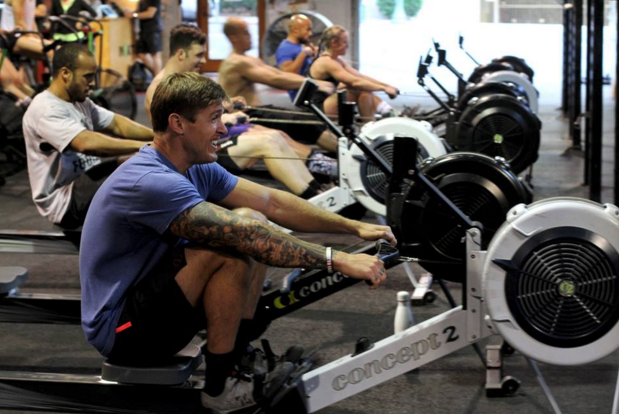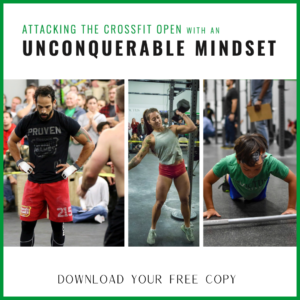
Is Your Pain Face Hindering Performance?
Written by Bryce Smith
If you have ever done interval training, chances are you know the feeling of discomfort. You can tell how hard many CrossFitters are working by simply looking at their face. The greater the effort, or at least their perception of effort, the more excruciating the “pain face” becomes. In the last part of many workouts, competitive CrossFitters exhibit what some people call the “stubbed-toe face” [1].
But is this “stubbed-toe face” helpful or detrimental to your performance?
Last year, as the Invictus team was training for regionals, we had to perform a workout that included intervals with the assault bike, burpee box jumps, heavy kettlebell swings, and pull-ups. I was on my fifth interval when I began to feel my face tense, my teeth grind, and my eyebrows get pulled down toward my eyes. My facial muscles were contracting as a part of my overall effort, which is not unusual, but on this particular occasion, I happened to notice it. While on the assault bike I kept repeating something I had heard before, “The best athlete is the most relaxed athlete.” I managed to calm my heart rate a bit and that particular interval ended up being my fastest. When I got home that day, I opened up my computer and began researching the “pain face” topic.
After a few lucky clicks, I managed to come across an article that reviewed a research paper entitled, “The face of effort: Frowning Muscle Activity Reflects Effort During a Physical Task” written by a famous exercise physiologist named Samuele Marcora. The article stated that Marcora was interested in the perception of effort with regards to exercise and he believed that this perception of effort phenomenon is the sole cause of fatigue [1]. Marcora believes that our exercise performance declines because we perceive the task to be very difficult and believe it requires a high amount of effort. This perception leads to us giving up when we can’t stand the suffering any longer [1].
Perception of effort is subjective to each person. I work with people all the time who claim to be working hard, but have no idea what intensity is and so they make facial expressions, grunt, and appear out of breath to reduce their effort and intensity. It seems very challenging to measure this concept by simply asking an athlete to rate their effort and then believe their answer is reliable.
Marcora tested frowning specifically as the indicator of perception of effort. He placed EMG sensors on the faces of athletes while they trained. These sensors measured the amount of electrical activity in the face during leg extensions. He also placed EMG sensors on the active leg muscles to measure actual work intensity. In addition to the sensors, he had the athletes rate their perception of effort during different times in their training session. The results of this experiment showed that frowning muscle activity does reflect the effort during physical tasks [1].
Frowning requires a certain amount of effort in and of itself. This effort requires ATP to help produce muscle contractions to make the frown. Is it efficient for high level athletes to waste energy on their facial expressions which do not help them accomplish the task at hand? No. It is simply a waste of energy and effort.
There is a famous triathlete named Natascha Badmann who won the Hawaii Ironman six times between the years of 1998 and 2005. She was famous for smiling during her races, which people were mind-boggled over at the time, but perhaps she was on to something [1]. It could be possible that she won all those races partly because she was able to smile and stay calm in the face of adversity. There is a famous line from the song Hall of Fame by The Script where they say, “You can go the distance. You can run the mile. You can run straight through hell with a smile.” This idea that you can endure pain with a smile can help keep you relaxed in the face of adversity which, in turn, can help to boost your performance.
So next time you are starting to get smacked around by the fatigue fairy, smile right in her face.
CrossFit Open Mindset
With all the hype that surrounds the Open each year, it is easy to begin to put some kind of pressure on yourself to perform a certain way. But remember…
“Full effort is full victory.”
What does that mean exactly? We put together a manual to talk about exactly that and more. Download your FREE “Attacking the CrossFit Open with an Unconquerable Mindset” PDF for tips on how to approach the Open including:
– Leaderboarding
– Measuring Success by Effort
– Mental Preparation
– Visualization
– Workout Strategy
And some additional bonuses and tips for:
– When to Attack the Open Workouts
– Equipment Considerations
– Nutrition Guidelines
While we can’t provide specific notes (exclusive to our online program subscribers) until we know the details of each workout, we hope that this general guide to approaching the Open at least gives you some of the tools to thrive in the upcoming Open. You’ve worked hard to prepare, and you should reap the rewards of your hard work with a good game plan and proper execution.
References
1) Fitzgerald, Matt. “Faces Of Pain: Smile To Run Better.” Competitor.com. Competitor Group Inc., 29 Apr. 2014. Web. 22 Nov. 2015.

Awesome
Very thought provoking article. I know when I’m pushing to the max my face probably looks like an ogre in labor, horrible visual Lol, but you’re right, I can feel how tense it is.